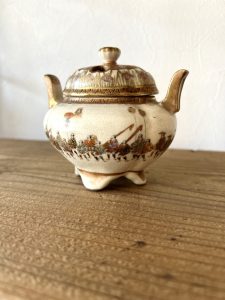大名行列は想像とはかなり違っておりました(愛知県名古屋市千種区姫池通 骨董買取 古美術風光舎)
2025.01.22
本日は私の裸眼ではもはや絵柄の細部まで見ることのできない、高さ7cmほどの小さな薩摩焼の香炉を眺めております。大名行列が側面にぐるりと描かれています。

正直なところ眼鏡をかけてもよく見えず、スマホで写真を撮って拡大して覗いてみますと、大名行列の一人一人の着物の柄まで丁寧に描かれております。着物を腰までたくし上げ一見するとあまり緊張感のないのどかな行列にも見えます。
大名行列といいますと、「下にー下に」の声とともに仰々しく練り歩き、邪魔をしようものなら斬り捨て御免の世界かと思っていました。また学校の授業では1年ごとに江戸と領地を行き来させることで大名の財政を圧迫し、江戸幕府に歯向かう力をつけさせないために行われたと習い、ずっとそう思い込んできましたが、現在では見解が少し変わってきているようです。
そもそも参勤交代は、鎌倉時代に御家人たちが鎌倉に参勤していたことが起源とされ、豊臣秀吉も大名を大坂城に呼び、裏切らないように妻や子供も本拠地の大坂に住まわせていました。
徳川家康が天下を取ると、はじめは大名たち忠誠を誓うため自ら江戸へ向かっていたということですが、3代将軍、徳川家光が参勤交代として制度化しました。結果として、参勤交代により大名の財政はひっ迫しましたが、それ自体が目的ではなく幕府への忠誠を誓わせ、主従関係を確認させることに重きを置いていたとのこと。
そして「下にー下に」の声で土下座するのは将軍行列の時だけで、大名行列の時は邪魔にならぬよう道の端に寄っていればよく、ともすれば行列を見物するというのは庶民の娯楽でもあったようです。
あんなに大勢で隊をなして長距離を歩くのはさぞ大変なことだったろうと想像していましたが、実際には行列で豪華さを見せつけるのは、宿場町に入る直前だけで、山道や村を通る時には、藩士たちは歩きやすい服装で、気の合う仲間同士で気ままに歩いていたそうな。なんだかちょっと拍子抜けしてしまいますが、ほのぼのとした気持ちにもなります。
また荷物を運ぶ「人足(にんそく)」を各宿場で雇い、次の宿場まで運ばせるというリレー方式をとっていたとか。
なにしろ、藩主が日々の生活で使う生活用品を一切合切江戸に持ち込むため、かなりの荷物だったと想像できます。衣服、什器、囲碁将棋の娯楽道具、鷹狩の道具 などまるで城ごと移動するようだったと言われています。
そして何より全員が泊まる宿をどうやって確保していたのでしょう?外様大名の多くは4月に江戸へ参勤すべしとされており、他の藩とのダブルブッキングなどはなかったのでしょうか?現代のようにパソコンやスマホが無い時代に、手違いが無いよう計画するのは至難の業に思えます。
川などの氾濫などで足止めされると、そのあとの宿の予約が全てずれてしまい、キャンセル料など多額の費用がかかったそうです。予約係の方の苦労が偲ばれます。
いよいよ江戸に入府となると、さらに多くの人の目に触れることとなり、少しでも行列を豪華に見せたいという思いから、「渡り者」と呼ばれるアルバイトは臨時で雇い行列を大きく見せたとのこと。
その見栄の張り合いはエスカレートし、参勤交代の費用は藩の財政の半分ほどにもなったとか。
これは幕府が望んだことではなく「武家諸法度」でも「最近従者の数が多すぎる。その費用を賄う領民の負担となっているので分相応の数に減らすこと」という命令も出されています。
しかし他藩への見栄の張り合いは収まることがなかったようです。
考えてみると結果的に道が整備され宿場町の商業は栄え、様々な文化が交流する機会にもなりました。
江戸の豊かな文化を育んだ一因かもしれません。そして戦がなくなったのは何よりの成果ですね。
そういえば大泉洋さん主演の参勤交代の映画がありましたね。無性に見たくなってきました。
それでは、また次の機会に(スタッフH)
Today I am looking at a small Satsuma-yaki incense burner, about 7 cm high, in which I can no longer see the details of the design with my naked eye. A procession of feudal lords is painted all around the side.
To be honest, I could not see it clearly even with my glasses on, so I took a picture of it with my smartphone and enlarged it to take a peek. At first glance, the procession looks peaceful, with kimono pulled up to the waist, without a sense of tension.
I had thought that the Daimyo procession was a world where people paraded in an ostentatious manner, shouting, “Down, down, down,” and if anyone tried to interfere, they would be cut down. I had also learned in school that the procession was conducted to put pressure on the feudal lords’ finances by having them travel back and forth between Edo and their territories every year, so that they would not have the power to oppose the Edo shogunate, and I had always believed this, but now it seems that the view has changed a little.
To begin with, it is said that the “daimyo” (feudal lords) used to visit Kamakura during the Kamakura period (1185-1333), and Toyotomi Hideyoshi also called the feudal lords to Osaka Castle and had his wife and children live in his home base, Osaka, to prevent them from betraying the shogunate.
When Ieyasu Tokugawa took over the reign of the shogunate, he personally went to Edo to swear fealty to the feudal lords, but the third shogun, Iemitsu Tokugawa, institutionalized the system as the “daimyo’s visit to the castle. As a result, the daimyo’s finances became strained due to the visit, but this was not the purpose in itself, and the emphasis was on making the feudal lords swear loyalty to the shogunate and confirming the relationship of master and servant.
During the daimyo’s procession, the procession was held at the side of the road so as not to disturb the procession, and it seems that watching the procession was also a pastime for the common people.
I had imagined how difficult it must have been to walk such a long distance in such a large group, but in reality, the procession only showed off its splendor just before entering an inn town, and when passing through mountain paths and villages, the feudal warriors walked freely amongst themselves in comfortable clothing. It is a bit disconcerting.
Also, it is said that “ninzoku” were hired at each inn to carry luggage, and the luggage was relayed to the next inn.
The luggage was quite heavy, as the feudal lords brought all the daily necessities they used in their daily lives to Edo (now Tokyo). It is said that it was like moving the entire castle, including clothes, furniture, tools for playing Go (Japanese chess) and Shogi (Japanese chess), and tools for falconry.
And above all, how did they secure lodging for all of them? Many of the foreign feudal lords were required to go to Edo in April, so were there any double bookings with other clans? In an age without computers and smartphones like today, it seems extremely difficult to plan without making mistakes.
If a traveler was stranded due to flooding of a river or other cause, all subsequent reservations for lodging would be delayed, resulting in a large cancellation fee and other expenses. I can only imagine the hardships faced by the reservation staff.
When the procession finally entered Edo, it would be seen by even more people. In order to make the procession look as luxurious as possible, part-time workers called “watarimonos” were hired on a temporary basis to make the procession look bigger.
The pretentiousness of the procession escalated to such an extent that the cost of the procession became as much as half of the clan’s finances.
This was not what the shogunate wanted, and even the “Laws of the Warrior Clans” stated, “Recently, the number of attendants has become too large. The shogunate also issued an order in the “Laws of the Warrior Clans” that the number of retainers should be reduced to a commensurate number, as it was becoming a burden on the local people who had to cover the cost of the retainers’ services.
However, it seems that the rivalry to show off to other clans did not stop.
However, when one thinks about it, as a result, the roads were improved, commerce in the inn towns flourished, and various cultures had opportunities to interact with each other.
This may have been one of the factors that nurtured Edo’s rich culture. And the fact that there were no more wars is the most important result of all.
By the way, there was a movie starring Yo Oizumi about the journey to Edo. I have an irresistible urge to see it.
See you next time (Staff H)
*******************
ご実家の整理やお片付けなどをされている方のご相談などが多くございます。
お片付けなどくれぐれもご無理のないようになさってくださいませ。
風光舎では古美術品や骨董品の他にも絵画や宝石、趣味のお品など様々なジャンルのものを買受しております。
お片付けをされていて、こういうものでもいいのかしらと迷われているものでも、どうぞお気軽にご相談下さいませ。
また風光舎は、出張買取も強化しております。ご近所はもちろん、愛知県内、岐阜県、三重県その他の県へも出張いたします。
まずは、お電話お待ちしております。
愛知県名古屋市千種区姫池通
骨董 買取【古美術 風光舎 名古屋店】
TEL052(734)8444
10:00-18:00 OPEN
#出張買取#骨董#古美術#骨董品#絵画#版画#茶道具#刀剣#彫刻

